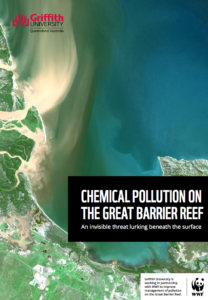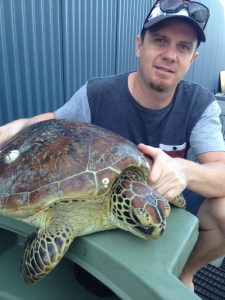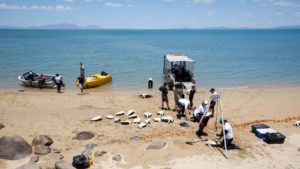
Toxic chemicals are accumulating in Great Barrier Reef turtles and fish species popular with consumers, according to a new report by Griffith University and the World Wide Fund for Nature Australia.

The report, Chemical pollution on the Great Barrier Reef - an invisible threat lurking beneath the surface, was launched this week reveals that the Rivers to Reef to Turtles project detected about 4000 chemical compounds in coastal green turtles on the Great Barrier Reef.
Griffith University's Dr Jason van de Merwe, a marine ecologist and ecotoxicologist at the Australian Rivers Institute, says it's vital the public is made award of the potential health risks associated with chemical contamination of marine habits and seafood.
"There have been tens of thousands of chemicals identified as contaminants of emerging concern. but Great Barrier Reef water quality programs only screen for sediment, nutrients, and pesticides. That's just the tip of the iceberg.
"They should be testing for commonly used chemicals - such as antifouling paint, plasticizers, flame retardants, hydrocarbons (from fuels), UV filters in sunscreens, pharmaceuticals and personal care products - and how they affect our reef and the species that call it home."

Turtles in the region have showed signs of poor health associated with exposure to chemical pollution.
"Based on the science we now know that it is possible turtles are absorbing more than 4000 compounds, which is staggering," said Christine Madden Hof, WWF Marine Species Project Manager.
"We found heart medication, gout or kidney stone medication, industrial adhesive, sealant and lubricant, metals including cobalt, herbicides and pesticides in turtle blood.
"The fact that many of the compounds could not be identified means turtles are being exposed to new and emerging contaminants, making corrective action all the more urgent," she said.
Ms Madden Hof described turtles as the canary in the coal mine and suspects the contaminants are also impacting the health of other reef species from whales, dolphins, dugongs and sharks through to the fish, prawns and mud crabs caught by commercial and recreational fishers.
The report cites previous studies which found chemical pollution in Queensland's two most high-profile fish species - barramundi and coral trout.
"The chemicals which wash into reef waters can degrade in to new compounds that are actually more toxic than the original chemicals," Dr van de Merwe said.
"With a cocktail of so many different chemicals there is the added problem of them potentially mixing together to form new even more dangerous combinations.
"We know very little about the toxicity of a lot of these chemicals on their own, let alone about how harmful they are when they mix together."

The key recommendations in the Chemical pollution on the Great Barrier Reef report are to:
- Identify toxic hotspots on the Great Barrier Reef through expanded chemical contamination monitoring
- Overhaul catchment-wide chemical identification and regulation to eliminate unsafe use
- Deploy improved and innovative monitoring techniques as early warning signals of harmful chemical change
- Regulate to ensure industry reef users deliver Reef Plan 2050 land and catchment management targets
Act quickly to remediate toxic hotspots to help future-proof the reef






